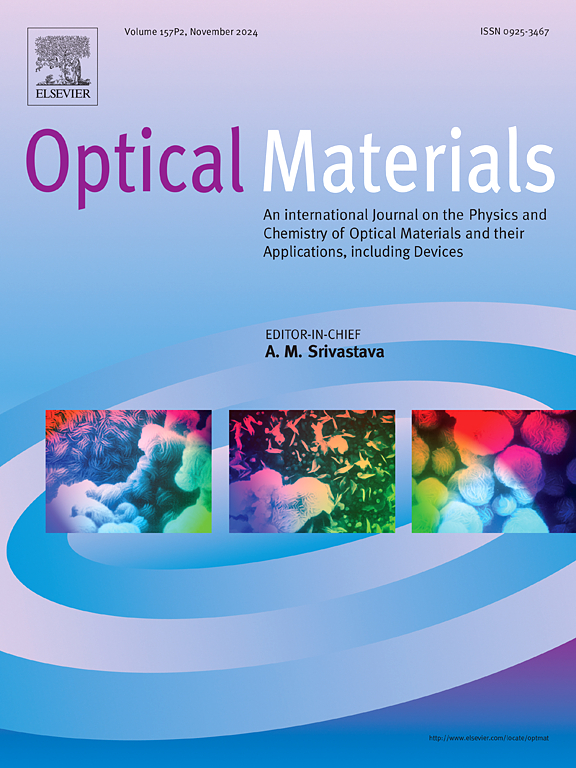增强光电应用中 PEO/PMMA/TiO2 纳米复合材料的光学和电学特性
IF 3.8
3区 材料科学
Q2 MATERIALS SCIENCE, MULTIDISCIPLINARY
引用次数: 0
摘要
在这项研究中,我们通过溶胶-凝胶工艺合成了氧化钛(TiO2)纳米粒子(NPs),并将其加入到聚氧化乙烯(PEO)和聚甲基丙烯酸甲酯(PMMA)的聚合物混合物中,形成了 PEO/PMMA/TiO2 纳米复合材料。采用浇铸法将不同浓度(1、2 和 3 wt%)的 TiO2 NPs 集成到聚合物基体中。利用透射电子显微镜 (TEM)、X 射线衍射 (XRD)、傅立叶变换红外光谱 (FTIR)、紫外可见光 (UV-Vis) 光谱和电阻抗光谱 (EIS) 等技术对制备的 TiO2 和纳米复合薄膜的结构、形态、光学和电学特性进行了全面表征。TEM 分析显示,TiO2 NPs 主要呈球形,平均粒径为 15 纳米。XRD 和傅立叶变换红外光谱分析证实了二氧化钛 NPs 的成功加入及其与聚合物链的相互作用,从而改变了纳米复合材料的晶体结构和化学键。紫外可见光谱显示,TiO₂含量越高,吸收边缘越红移,吸光度越高,表明光学性能增强。据观察,随着二氧化钛浓度的增加,间接光带隙从 4.19 eV 减小到 2.21 eV,从而增强了材料的光致反射性。此外,折射率从 2.11 上升到 2.91,进一步证明了该材料在光学应用方面的潜力。EIS 结果表明,随着 TiO2 浓度的增加,体积电阻有所下降,这表明导电性有所改善。这些发现凸显了 PEO/PMMA/TiO2 纳米复合材料在光电应用方面的潜力,在光电应用中,增强的光学特性,如更好的光吸收、更高的折射率和更好的电荷传输,对器件性能至关重要。本研究有助于了解 PEO/PMMA/TiO2 纳米复合材料,为今后研究其在光电器件中的应用奠定基础。本文章由计算机程序翻译,如有差异,请以英文原文为准。
Enhanced optical and electrical properties of PEO/PMMA/TiO2 nanocomposites for optoelectronic applications
In this study, we synthesized titanium oxide (TiO2) nanoparticles (NPs) via the sol-gel process and incorporated them into a polymer blend of polyethylene oxide (PEO) and polymethyl methacrylate (PMMA) to form PEO/PMMA/TiO2 nanocomposites. The TiO2 NPs were integrated into the polymer matrix using the casting method at varying concentrations (1, 2, and 3 wt%). The structural, morphological, optical, and electrical properties of the prepared TiO2 and nanocomposite films were thoroughly characterized using techniques such as transmission electron microscopy (TEM), X-ray diffraction (XRD), Fourier transform infrared (FTIR) spectroscopy, ultraviolet–visible (UV–Vis) spectroscopy, and electrical impedance spectroscopy (EIS). TEM analysis revealed predominantly spherical TiO2 NPs with an average particle size of 15 nm. XRD and FTIR analyses confirmed the successful incorporation of TiO2 NPs and their interaction with the polymer chains, leading to modifications in the crystalline structure and chemical bonding of the nanocomposites. UV–Vis spectroscopy demonstrated a redshift in the absorption edge and increased absorbance with higher TiO₂ content, indicating enhanced optical properties. The indirect optical bandgap was observed to decrease from 4.19 eV to 2.21 eV as the TiO2 concentration increased, enhancing the material's photoresponsiveness. Additionally, the refractive index increased from 2.11 to 2.91, further supporting the potential for optical applications. EIS results showed a decrease in bulk resistance with increasing TiO2 concentration, suggesting improved electrical conductivity. These findings highlight the potential of PEO/PMMA/TiO2 nanocomposites for optoelectronic applications, where enhanced optical properties, such as improved light absorption, higher refractive index, and improved charge transport, are critical for device performance. The study offers an understanding of the PEO/PMMA/TiO2 nanocomposites, laying a foundation for future research in their applications in optoelectronic devices.
求助全文
通过发布文献求助,成功后即可免费获取论文全文。
去求助
来源期刊

Optical Materials
工程技术-材料科学:综合
CiteScore
6.60
自引率
12.80%
发文量
1265
审稿时长
38 days
期刊介绍:
Optical Materials has an open access mirror journal Optical Materials: X, sharing the same aims and scope, editorial team, submission system and rigorous peer review.
The purpose of Optical Materials is to provide a means of communication and technology transfer between researchers who are interested in materials for potential device applications. The journal publishes original papers and review articles on the design, synthesis, characterisation and applications of optical materials.
OPTICAL MATERIALS focuses on:
• Optical Properties of Material Systems;
• The Materials Aspects of Optical Phenomena;
• The Materials Aspects of Devices and Applications.
Authors can submit separate research elements describing their data to Data in Brief and methods to Methods X.
 求助内容:
求助内容: 应助结果提醒方式:
应助结果提醒方式:


